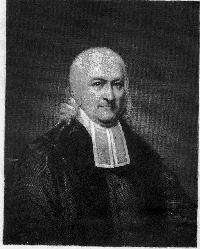John Henry Livingston
| John Henry Livingston | |
|---|---|
 | |
| Born |
May 30, 1746 near Poughkeepsie, New York |
| Died |
January 25, 1825 (aged 78) New Brunswick, New Jersey |
| Education |
Yale College (1762) Utrecht University |
| Occupation | Minister |
| Employer | Rutgers University |
| Title | President of Rutgers University |
| Term | 1810-1825 |
| Predecessor | Ira Condict |
| Successor | Philip Milledoler |
| Spouse(s) | Sarah Livingston |
| Parent(s) |
Henry Livingston (1714-1799) Susannah Conklin (1724-1793) |
John Henry Livingston (May 30, 1746—January 25, 1825) was the fourth President of Queen's College (now Rutgers University), serving from 1810 until his death in 1825.
Biography
He was born on May 30, 1746 near Poughkeepsie, New York. His great-grandfather was Robert Livingston the Elder, first lord of Livingston Manor. John Henry Livingston graduated from Yale College with a Bachelor of Arts in 1762. He earned a Doctor of Theology from the Utrecht University and was ordained into the ministry of the Dutch Reformed Church by the Classis of Amsterdam in 1770. Subsequent to his return from the Netherlands, Livingston served as a pastor to the Reformed Church in New York City. He became a leading figure in the church and negotiated the peaceful reunifications of its two opposing factions. On November 26, 1775, Livingston married his second cousin, Sarah Livingston, a daughter of Philip Livingston and his wife. Their children included son Henry A. Livingston (1776–1849), who was elected as a New York State Senator.
When Queen's College offered Livingston the presidency as early as 1807, he initially declined. However, the Trustees continued to offer, and Livingston accepted the post in 1810. He was also a professor of theology. Queen's College fell into financial trouble and was forced to close its doors in 1816. Livingston continued teaching at the New Brunswick Theological Seminary (which shared facilities with Queen's College), and continued to lobby and fundraise for the reopening of Queen's College. This was gained ten months after his death in 1825.[1]
After being chosen to head Queen's College, Livingston purchased a 150-acre (0.61 km2) plot of land in nearby Raritan Landing, which was afterward known as the Livingston Manor. A Greek Revival mansion built by descendants Robert and Louisa Livingston around 1843 stands on the property, now known as Livingston Homestead. At the turn of the 20th century, the property was developed as a streetcar suburb. In 2004 it was designated as part of the Livingston Manor Historic District.[2] The house and the district are listed on the New Jersey Register of Historic Places and the National Register of Historic Places.[3][4]
See also
References
- ↑ "John Henry Livingston, 1810-1825". Rutgers University. Retrieved August 26, 2007.
In 1810, the Reverend John Henry Livingston (1746-1825), left the Reformed Dutch Church in New York City and headed for New Brunswick, to preside as the new President and Professor of Theology of Queen's College. The most influential minister in the Dutch Church at that time, he had agreed to accept the position with limited responsibilities to the College. But to the theological students who came under his wing, he would devote his undivided attention. Livingston was born in Dutchess County, near Poughkeepsie, N.Y., graduated from Yale College in 1762, and by 1766, the year Queen's College was founded, set sail for Amsterdam to study theology. He was licensed and ordained by the Classis of Amsterdam in April 1770, and one month later received the degree of doctor of theology from the University of Utrecht. ...
- ↑ Spies, Stacy. National Register nomination for Livingston Homestead (Washington, DC, National Park Service, 2001).
- ↑ "New Jersey and National Registers of Historic Places - Middlesex County" (PDF). NJ DEP - Historic Preservation Office. June 2, 2011. p. 11. Retrieved July 5, 2011.
- ↑ "New Jersey - Middlesex County". National Register of Historic Places. Retrieved July 5, 2011.
